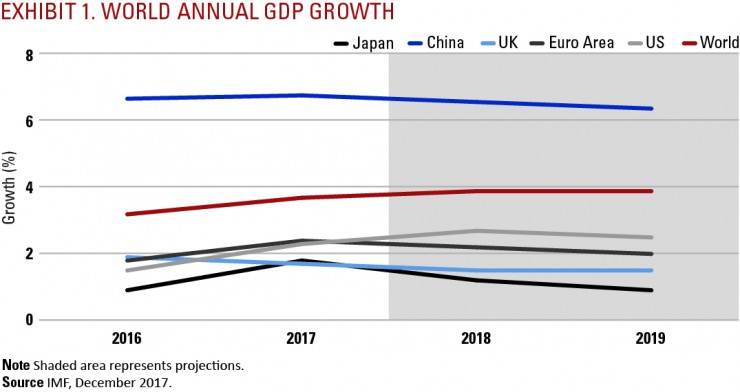Global Economic Outlook
April 14th 2018 | , Urban Property Australia
The global economic landscape found itself under sunnier skies during 2017. Just over a year ago, developed economies were gazing into the potential darkness of economic declines, with central banks resorting to negative interest rates. Since the third quarter of last year, however, world economies have rebounded and found a steady, upward path.
The International Monetary Fund (IMF) estimates global output to have grown by 3.7% in 2017, and has revised 2018 and 2019 estimates upward to 3.9% (see Exhibit 1).
The acceleration reflects the broad-based nature of global growth, better-than-expected performance in Europe and Asia, and the expected impact of tax policy changes in the United States. According to the IMF, approximately 75% of the world economy is experiencing expansion, which is the greatest increase in global economic activity since 2010.

The gains were most noticeable across Europe, where the anxiety wrought by Brexit gave way to a more tempered outlook. Negotiations between European Union (EU) and UK leaders in March led to an approved deal for a 21-month transition period, which effectively maintains the relationship through 2020 and helps bring some certainty to the timing and process. While the UK’s economy posted a moderate 1.7% gain in 2017, according to the IMF, it was nowhere near the recession expected a year ago. After years of anaemic growth following one debt crisis after another, the EU experienced its best growth since 2007. Ireland remained the fastest growing EU economy for the fourth year in a row. While economic growth in the EU was broad-based, the largest gains came mostly from peripheral countries during 2017 with Romania, Malta, Slovenia and Estonia all recording GDP gains of at least 4%, according to IMF data. The other developed eurozone economies — Germany, France, Italy and Switzerland — displayed more modest economic conditions, with GDP growth in the 1-2% range.
Asian economies continued moving with solid upward momentum during the year. China’s GDP increased at a 6.8% annual rate in 2017, according to the IMF, but is expected to decelerate slightly to 6.4% in 2018 due to its deleveraging efforts to cut risk in its financial system, including government and corporate debt.
The Bank of Japan has hinted that it might finally reduce its monetary stimulus program in 2020 as it expects inflation to reach its 2% goal sometime around fiscal year 2019. India’s economy continued its growth pattern, despite the country’s massive currency adjustment in 2016, with GDP growth poised to average 7.9% per year over the next four years, according to the IMF. Other Asian economies — Indonesia, Malaysia, Philippines, South Korea, Thailand and Vietnam among them — reflected the strength of neighbouring larger economies with 2017 GDP growth in the solid 3-6% range.
In the Americas, economic trends underscored a rising global tide. In Canada, the economy grew at over double the pace of 2016, with GDP growth registering 3% in 2017, led by consumer spending and investment in inventory and businesses.
While economists expect moderation going forward, the outlook for 2018 remains positive in Canada. Mexico’s economy took a more moderate path, with GDP projected to close 2017 with a 2.1% gain. In March 2018, Canada and Mexico’s renegotiations of the North American Free Trade Agreement (NAFTA) with the US took an optimistic turn as the US softened its stance on importing goods for use in its auto industry – one of the most contentious issues in the talks. While several issues remain, there is optimism of a new NAFTA deal being announced within the next month. Canada and Mexico will also be exempt from the 25% tariffs on imported steel and 10% on aluminium during negotiations. Brazil’s economy, recovering from its mild recession, grew 1% in 2017 – its first year of expansion since 2014. Argentina’s economy found a more solid footing in 2017, with GDP gaining 2.5%. However, a prolonged drought affecting Argentina’s soybean and corn crops is expected to weaken the country’s performance in 2018. The economies of Colombia and Chile remained positive, with 1.7% and 1.4% GDP growth, respectively, while Venezuela’s political crisis continues to deepen its economic woes and the humanitarian crisis in the country.
A major engine of global economic activity, the US is in its ninth consecutive year of expansion.
The central bank continued to tighten its monetary policy, increasing the federal funds rate by 25 basis points in March 2018 amid low unemployment, growing GDP and expected stimulus from tax reform. Optimism about economic conditions continues to keep the unemployment rate low amid higher wages and increased business investment and consumer spending. The Fed indicated that there would likely be two more rate hikes this year, despite still-modest inflation. The few clouds hanging in the economic skies were additional federal spending and the rising national debt, slowing momentum in the housing market and continued declines in commercial real estate investment volume, which caused concern about the current real estate cycle’s timing and duration.



